The iPhone SE Review
by Brandon Chester on May 16, 2016 8:00 AM EST- Posted in
- Smartphones
- Apple
- Mobile
- iPhone
- iPhone SE
System Performance
With the iPhone SE I've decided to make the transition to our 2016 benchmark suite. We've been including some of these for a little while now, and some tests from our previous suite are still around. There is one test omitted, which is Basemark ES / Basemark Metal, which we'll be deploying once we have all the data from this year's flagship Android smartphones. Comparisons to those Android phones will also have to wait until their respective reviews, and for now I can only really compare the iPhone SE to Apple's other iPhones along with 2015's flagship Android devices.
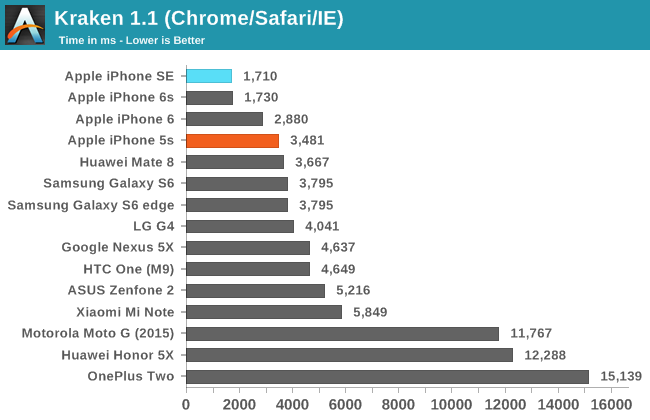
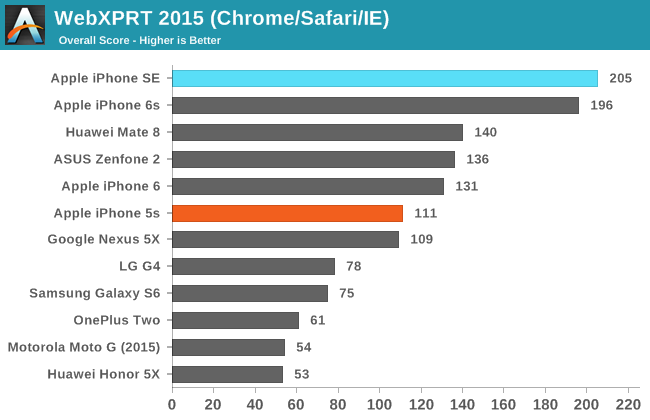
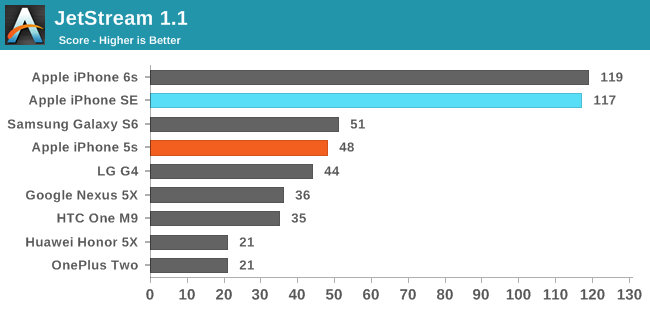
At this point I think we're ready to move to our 2016 web browser benchmarks. Octane is now retired, as there's a large degree of overlap between it and JetStream, with JetStream using a more sensible methodology with measurements for tests like the mandreel-latency test. Kraken, Octane, and Jetstream all have some overlap, but Kraken and JetStream are different enough to make it worth keeping Kraken on. Finally there's WebXPRT 2015, which we already introduced as a replacement for WebXPRT 2013 some time ago.
As expected, the iPhone SE matches the iPhone 6s in our JavaScript tests. The improvement over the iPhone 5s is significant, with roughly double the performance in all cases. This is right in line with Apple's 2x performance claim, and it's important to note that these are updated iPhone 5s figures run on iOS 9 to ensure that it also benefits from the improvements made to Apple's Nitro JavaScript engine since it launched in 2013.
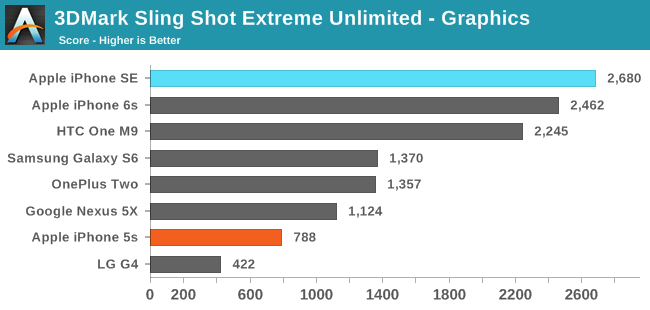
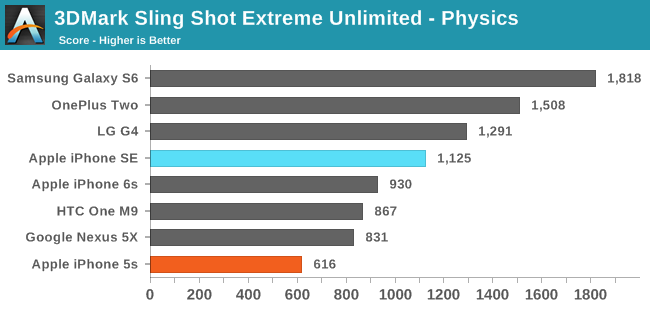
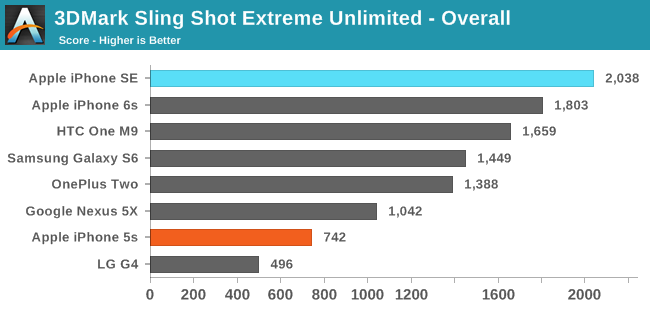
We originally planned to use 3DMark Sling Shot Unlimited, which is an OpenGL ES 3.0 test that runs off screen 1920 x 1080 tests to produce results that are useful for comparing devices and SoCs. However, in the interest of test longevity we have moved to the even newer Sling Shot Extreme test, which uses OpenGL ES 3.1 on Android and Metal on iOS, with a Vulkan version coming to Android in the future. The tests in Sling Shot Extreme render off screen at 2560 x 1440, so it should be a good target for GPU performance well into the future.
In this test the iPhone SE performs well. I experienced a strange situation where the iPhone 6s would consistently score lower than the SE, and I'm not sure if this is due to driver differences or some other problem, but in any case the SE and the 6s both end up at the top of the chart, and the final score is nearly three times higher than that of the iPhone 5s. I'm still waiting on final reviews for this year's Android flagships, so comparisons to Snapdragon 820 and Exynos 8890 will have to wait a bit longer.
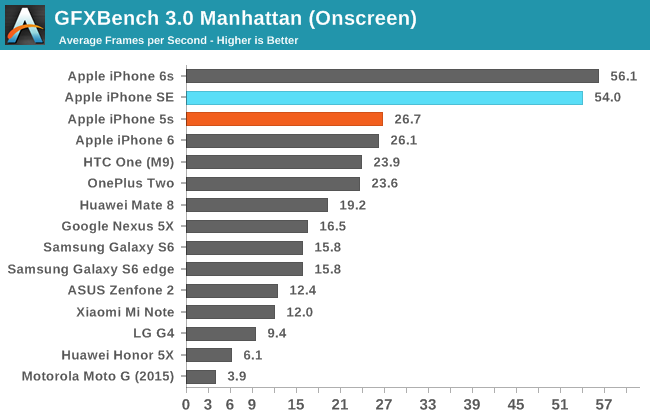
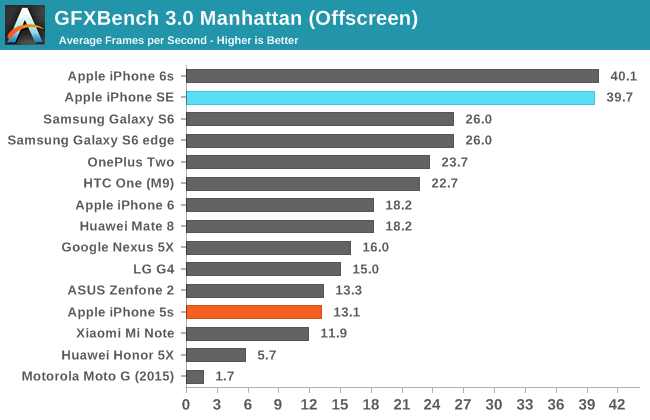
With T-Rex HD being such an old test, I've decided to retire it except perhaps for reviews of devices with relatively slow SoCs. That leaves GFXBench 3.0 Manhattan, and hopefully GFXBench 4.0 in the near future. In Manhattan the iPhone SE performs exceptionally well, achieving a frame rate that is ever so slightly more than three times that of the iPhone 5s. While there's obviously a degree of variance, I think this shows that Apple's 3x GPU performance claim is not an exaggeration, and on such a tiny display with a relatively low resolution you can render a scene like Manhattan at native resolution and almost achieve 60fps.
NAND Performance
With the first generation of the MacBook, Apple introduced their own PCI-E SSD controller with support for NVMe. At the launch of the iPhone 6s and iPad Pro, they noted that both devices had significantly improved storage performance. During the course of our review we discovered that Apple had essentially brought some version of their controller down to their mobile devices, and as a result they led the rest of the mobile market by a large margin when it came to overall storage performance.
With the iPhone SE, Apple uses the same controller as they do in the iPhone 6s and iPad Pro. Since this iPhone is a 64GB unit, we can take a look at the potential impact of a smaller SSD that may not be able to utilize parallelism to achieve the same performance as its 128GB and 256GB counterparts in Apple's other devices. To analyze the storage performance of the iPhone SE I've used StorageBench, a NAND benchmark developed by Eric Patno which is comparable to our AndroBench 3.6 test on Android.

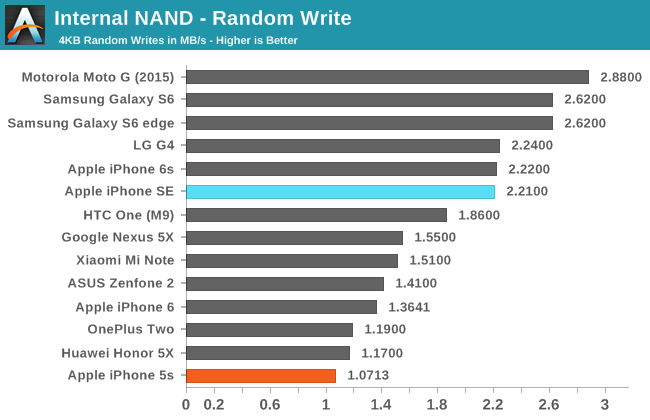
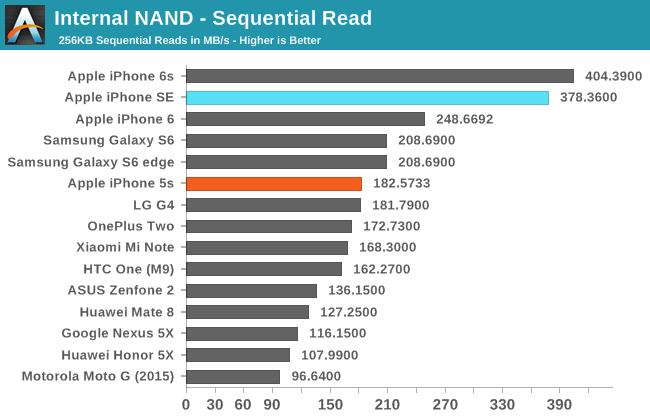
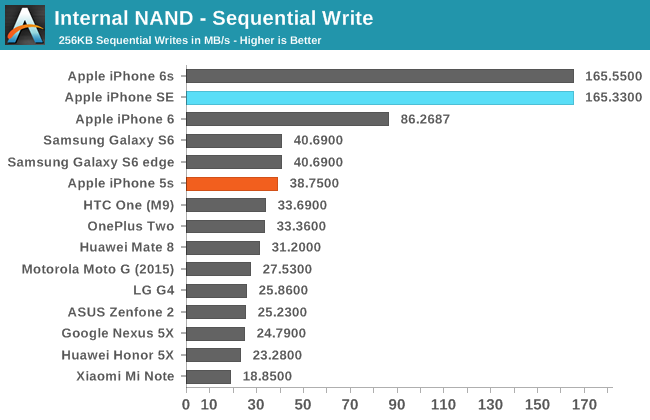
Despite the fact that the storage capacity is half that of our iPhone 6s review unit, the iPhone SE performs essentially just as well. Random reads actually end up being faster, while random writes are nearly identical. Sequential reads trail the 6s by a bit, but sequential writes end up being identical much like random writes. The differences are enough to attribute to testing variance, and it's probably safe to say that the storage performance on the 64GB iPhone SE is identical to that of the 64GB and 128GB models of the iPhone 6s.










138 Comments
View All Comments
Alexey291 - Monday, May 16, 2016 - link
So it's kinda buggy, badly built but you love it? Kaywhiteiphoneproblems - Monday, May 16, 2016 - link
Yep - two minor bugs. Never owned a phone (by any manufacturer) that was bug-free!Impulses - Monday, May 16, 2016 - link
They sound more like hardware faults or QC issues than bugs to me, but maybe we have different definitions of said word...whiteiphoneproblems - Tuesday, May 17, 2016 - link
That other guy called it "buggy"; OK word by me, I guess. The power button issue has been widely reported (think it goes back to the 5S), so don't know if a hardware swap would be worthwhile. (With a case, it's barely noticeable.)Don't know if the brightness thing is software or hardware. Maybe it's calibrated to work that way for this model? I can investigate further, I suppose.
All told, the advantages of this phone far outweigh these imperfections for me.
Klug4Pres - Monday, May 16, 2016 - link
I see a problem with Apple's strategy here.People who cannot afford Apple's larger phones do not necessarily want a smaller phone.
There is also the old problem that people who want large screen phones do not necessarily want gigantic bezels on their phones.
Might there be better ways to differentiate the product line?
Guspaz - Monday, May 16, 2016 - link
I helped my mother buy an iPhone SE yesterday (which was tricky since we visited 6 cellphone stores, all of which were sold out, before we finally found a store that had one in stock). She was upgrading from an iPhone 4S, since it was getting on in years and they'll likely discontinue software support for it this fall.For her, it was the perfect choice: she didn't like the iPhone 6S due to the much larger screen, and the much larger price. The iPhone SE sells for $579 CAD, while the iPhone 6S sells for $915 CAD (or at least it did yesterday in-store, looks like it's gone down to $899 since), which is a big price difference.
She was happy. A lighter phone without much of a size increase, at $336 cheaper than the 6S.
UtilityMax - Tuesday, May 17, 2016 - link
The fact that your ma likes a phone with a small screen does not disprove the previous argument. Apple has a huge problem on its hands. There are plenty of great android smartphones with large screens sold for under $400, heck many are priced exactly at around 200 bucks. Throwing a bone in the form of cheaper and smaller iPhone SE to the consumers looking for value will not appease most of them them.michael2k - Tuesday, May 17, 2016 - link
On the other hand, Apple has no competition in this space, as everything else in this size is significantly slower in CPU, GPU, and NAND.So people who want a small phone can get the SE, and have the fastest and most powerful phone. People who want a large phone can get the 6S and still have the fastest and most powerful phone.
jerrytouille - Monday, May 16, 2016 - link
Which CPU did the SE tested have: Samsung or TSMC?Spectrophobic - Monday, May 16, 2016 - link
Doesn't matter. Margin of error difference.